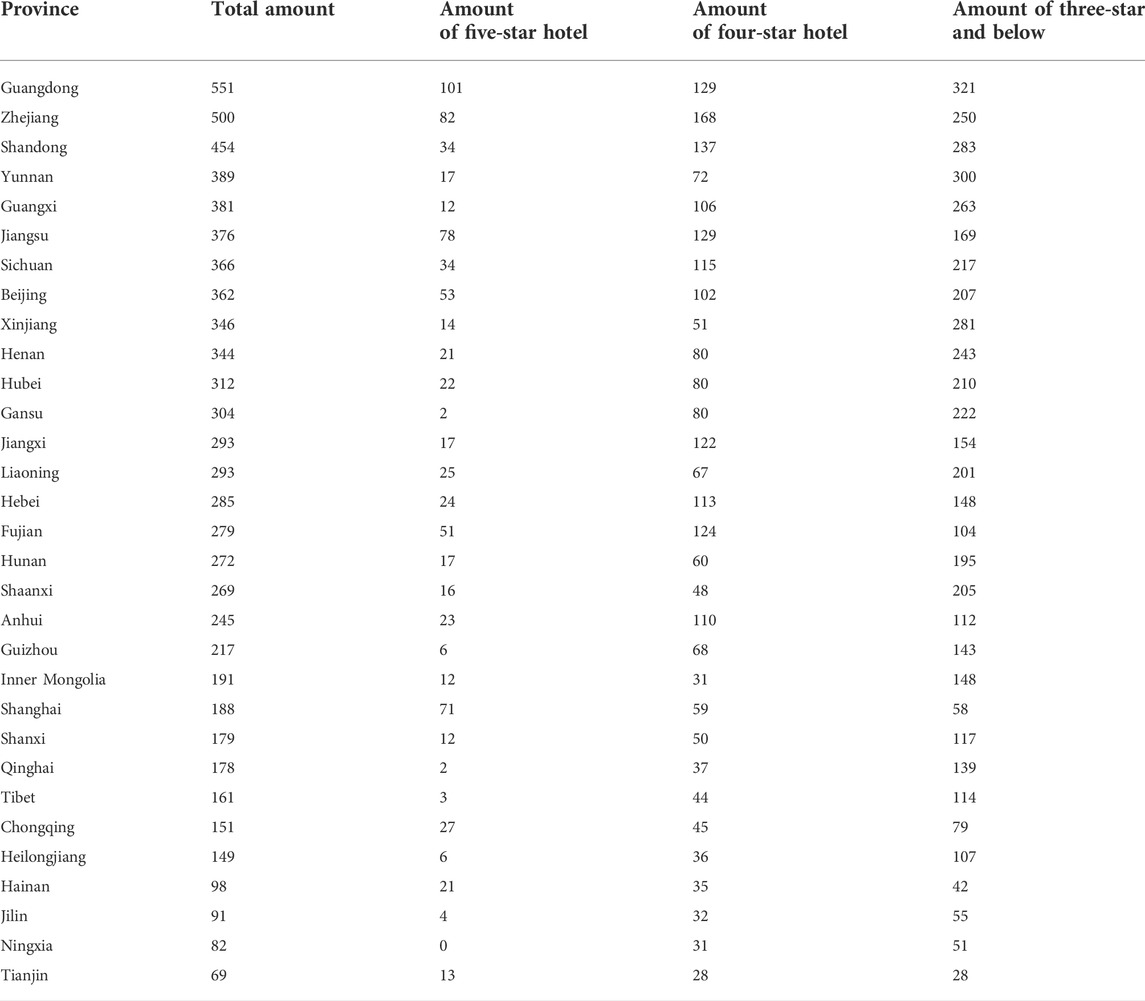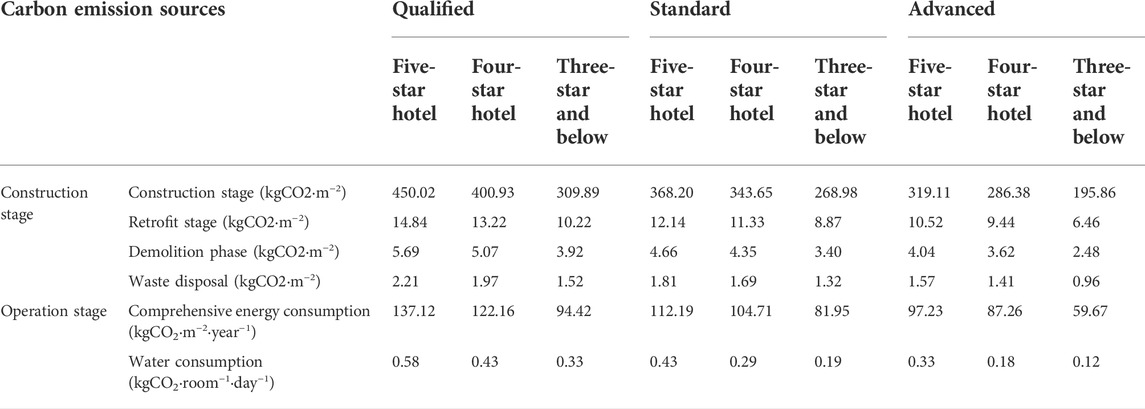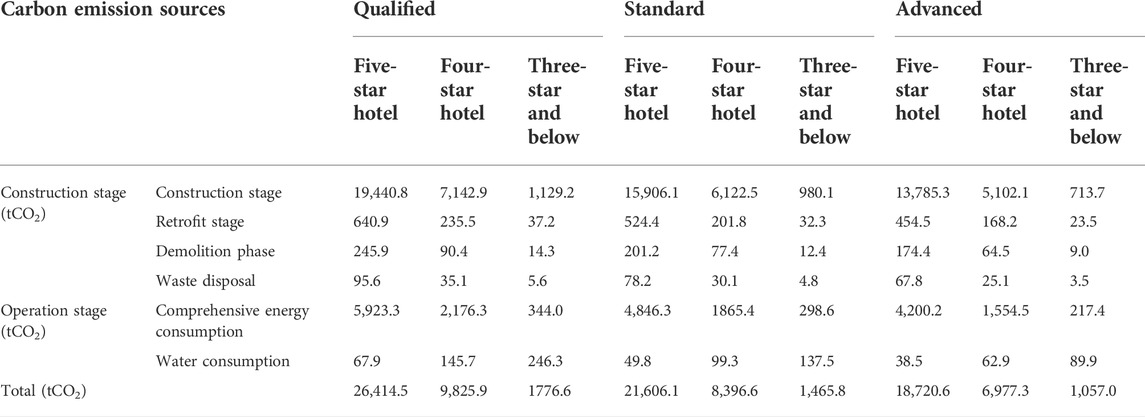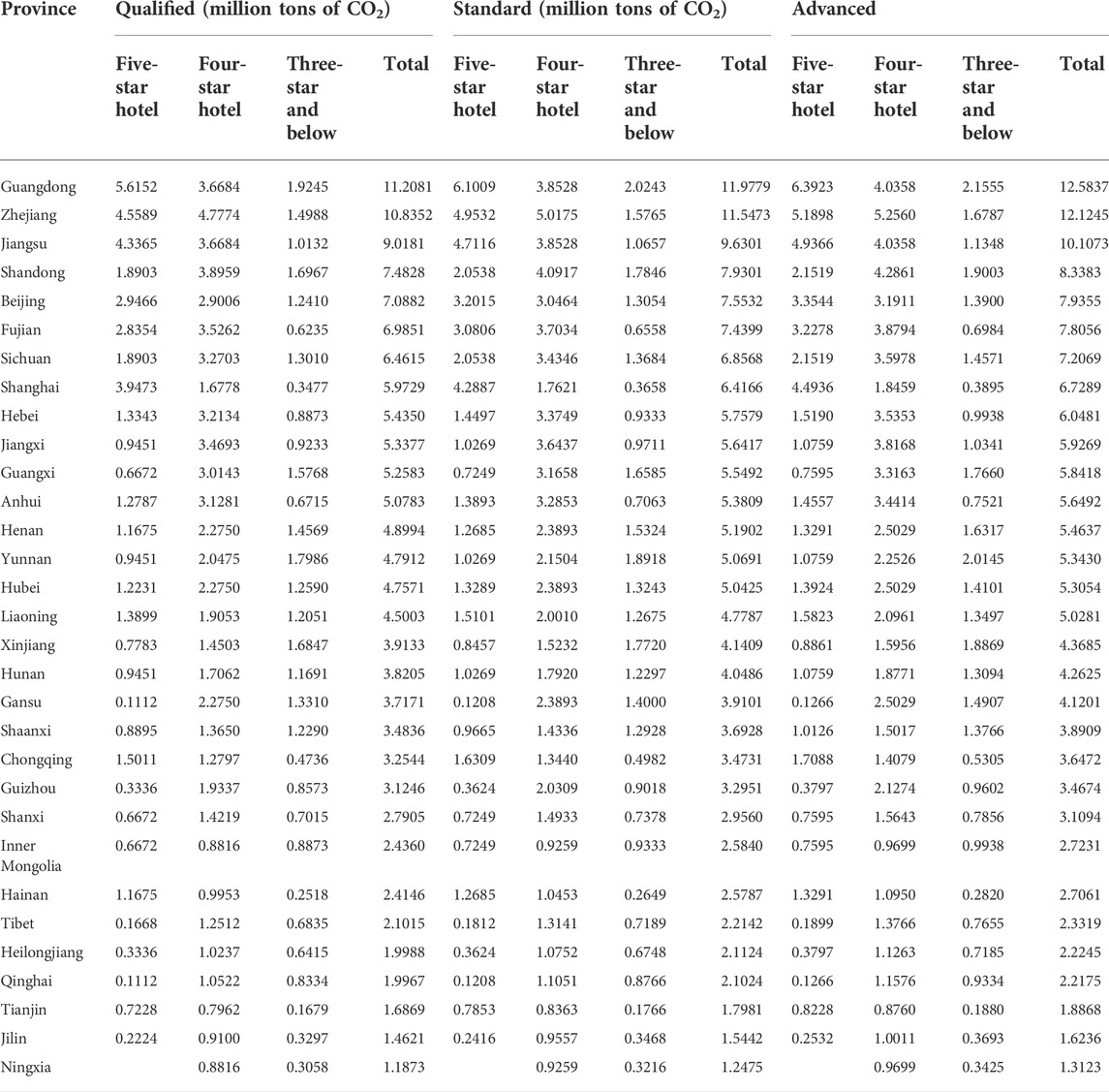- 1Xiamen University of Technology, Xiamen, China
- 2Tatung University, Taipei, Taiwan
- 3China Center for Energy Economics Research, School of Economics, Xiamen University, Xiamen, China
- 4MOE Key Laboratory of Econometrics, School of Economics, Xiamen University, Xiamen, China
The green transformation design of traditional hotels aims to reduce the consumption of materials and energy and reduce the emission of harmful substances. Carbon emission, usually used to measure energy consumption, is a representative indicator to evaluate the effect of the green transformation process. This paper adopts the emission factor method to measure the carbon emission reduction in the process of hotels’ green transformation from the whole life cycle of hotels, and the results show that: 1) From the perspective of the hotel life cycle, the construction process is the stage with the most carbon emissions. 2) From the perspective of a single hotel, high-star hotels have larger emissions than low-star hotels; 3) As the number of three and four-star hotels far exceeds the five-star hotels, overall, four-star hotels ranked first in total emission reduction. 4) From the perspective of provinces, the hotel industry emission reduction potential of different provinces varies greatly, among which Guangdong, Zhejiang, and Jiangsu provinces are at the top of the list. The future carbon reduction potential of the Chinese hotel industry is very considerable. The content of this paper enriches the research in the field of carbon emission measurement and also provides a reference for the management agency to designate the carbon peaking and carbon neutrality goals of the hotel industry.
Introduction
In recent years, issues such as greenhouse gas emissions and addressing climate change cannot be ignored in global sustainable development. Energy Information Administration, (2021) released by the U.S. Energy Information Administration predicts that from 2020 to 2050, total carbon emissions from OECD countries are expected to increase by 5% (600 million tons), and non-OECD countries will increase by 35% (8 billion tons). As the world’s largest carbon emitter, China’s carbon reduction policy has attracted worldwide attention. In September 2020, China proposed “We strive to peak carbon dioxide emissions by 2030 and achieve carbon dioxide emissions neutrality by 2060.” At the 75th United Nations General Assembly, In September 2021, the State Council unveiled a guiding document on the country’s work to achieve carbon peaking and carbon neutrality goals under the new development philosophy, which provided practical guidance for realizing the “Carbon peaking and carbon neutrality.” With feasible theoretical guidance, introducing a series of “dual carbon” policies has demonstrated China’s image as a major responsible country.
As a strategic industry that promotes global cultural exchanges and economic development, tourism accounts for 8% of the world’s carbon emissions and is growing at an annual rate of 3% (Wang et al., 2022), and the hotel industry is one of the three major industries in tourism industry. As one of the pillar industries of energy conservation, emission reduction and low-carbon transformation, the hotel industry is the key link for China to achieve the goal of “carbon peak and carbon neutrality.” How to guide hotel design to take environmental performance as the starting point, reduce material and energy consumption and emission of harmful substances is the key point of the current green transformation of traditional hotels. Research on these contents needs to be based on the measurement of carbon emissions in the hotel industry. However, there are few empirical papers on energy-saving and emission reduction in the hotel industry. Relevant studies are mainly based on field research in individual regions, and very few pieces of literature measure carbon emissions from the national hotel industry; most literature (Fu et al., 2019) remains on the qualitative discussion and theoretical analysis of the green hotel industry, and the quantitative research of green hotel industry is minimal.
Based on the previous research results, this paper uses the data published in the “Ministry of Culture and Tourism of the People’s Republic of China, 2020” to calculate the carbon emission reduction of the green transformation of various star-rated hotels in China, enriching the existing research in the field of carbon emission measurement. Discussing the primary sources of carbon emissions and promoting the concept of low carbon, is conducive to the implementation of the energy-saving and green design of hotels. It provides theoretical reference and empirical support for the management department to formulate “dual carbon” policies for the hotel industry and tourism.
The rest of the paper is organized as follows: the second part reviews the previously available literature, the third part is the calculation of carbon reduction, and the last part is the conclusion and policy implication.
Literature review
Green hotel-related standardization documents in China
As early as 2007, China issued the “National Standard for Green Hotels” (hereafter referred to as the “Standard”), which made qualitative regulations for the green operation and management of hotels. From green design, safety management, energy conservation management, consumption reduction management, environmental protection, health management, and green publicity, the “Standard” comprehensively divides green hotels into five-leaf levels to one-leaf levels according to their green performance from excellent to bad. Every 2 years, the green hotel enterprises that have been evaluated are reviewed, and the “Standard” preliminarily establishes the green hotel evaluation system. In 2011, the National Tourism Administration issued the “Guidelines for Energy Conservation and Emission Reduction in Tourist Hotels” (hereinafter referred to as the “Guidelines”), stating that tourist hotel enterprises should establish a management mechanism for energy conservation and emission reduction, including organization, implementation, and assessment; establish an independent measurement system for various types of energy, and conduct statistics and audits on energy consumption. The “Guidelines” makes detailed requirements for all aspects of the design and operation process in terms of hotel design, energy-using equipment, operation stages, and emission reduction transformation It also requires green hotels to conduct publicity and emission reduction guidance to consumers and actively purchase items with environmental protection certification; quantitative recommendation standards are set for the comprehensive energy consumption and water consumption of the hotel.
In 2016, the industry standard “Green Tourism Hotel” was issued to define the green tourism hotel—green tourism hotel refers to a hotel that adheres to the concept of sustainable development, adheres to clean production, maintains hotel quality, advocates green consumption, uses resources reasonably, protects the ecological environment, and undertakes community and environmental responsibilities. “Green Tourist Hotel” has formulated more detailed evaluation rules: the evaluation standards cover eight aspects: environmental management, green design, energy management, resource management, pollution prevention and control, product and service provision, safety and employee health management, and social responsibility; The evaluation is divided into two categories of 16 essential inspection items and seven categories of 150 evaluation items. The open detailed evaluation guidelines make the tourist hotel have the rule to follow and can carry out the green transformation more targeted. It also makes the rating agency scoring criteria more objective and persuasive, which will be beneficial to the green transformation of the hotel industry in the long run.
Most of the current standards and regulations on green hotels in China are still based on qualitative evaluation. Although some documents provide quantitative data, they are only recommended standards, and the data lack more theoretical and empirical data support. There is no detailed and specific quantification method for the emission measurement of the hotel industry in China. The green transformation process of hotels still needs to establish a sound and complete institutional system to make further specifications (Geng et al., 2020).
Overview of domestic and foreign research
In recent years, with the worsening of climate warming, how to control carbon dioxide emissions, the main greenhouse gas, has attracted attention from all walks of life, and the measurement of carbon emissions is the basis of quantitative emission reduction. The tourism industry represented by the hotel industry, as one of the long-term strategic pillar industries in the industrial structure, has also become a research hotspot in academia.
However, there are few pieces of literature about carbon emissions in the hotel industry. This paper also refers to the measurement methods of building carbon emissions that are strongly related to the hotel industry and finds that the existing literature mainly use life cycle assessment method and input-output method for carbon emission measurement. Filimonau et al. (2011) pointed out that the life cycle assessment (LCA) is suitable for the calculation of carbon emissions in the tourism hotel industry. Some scholars calculated the carbon emissions by dividing the hotel operation activities. Hu et al. (2015) took “One night’s hotel stay in a standard room” as an operations cycle and calculated a five-star hotel by constructing a complete consumption life cycle of service preparation, service provision and service completion. Similarly, Michailidou et al. (2016) measured the operation stage of Greek hotel industry by taking a 7-day journey operation as a life cycle. Other scholars construct the life cycle based on the stage of the hotel. Schwartz et al. (2018) divided the sources of CO2 emission during the whole life cycle of the hotel industry into five stages: embodied CO2; operations-related CO2; demolition stage; renewables and recycle stages. Peng et al. (2021) constructed a 50-years full life cycle from the physicochemical stage, usage stage and exhaust gas stage. This paper makes a comprehensive reference to these two piece of literature when establishing the life cycle.
Besides, LCEA (life cycle energy assessment) is a method for a more detailed classification of energy consumption. At present, many scholars in China also use this method to measure the carbon emissions of the hotel industry (Huang et al., 2015; Chen, 2019; He and Yang, 2019). Scholars in other countries have also applied this method, Oluseyi et al. (2016) calculated the hotel CO2 emission of electricity powered by diesel generation in Nigeria; Salehia et al. (2021) found that six luxury hotels in Iran produced 3–4 times more carbon emissions from energy consumption than other countries. Huang et al. (2014) further considered indirect emissions and used the emission factor method to calculate the carbon emissions of 21 hotels in Eastern China. Shen et al. (2017) also considered carbon dioxide emissions generated by solid waste treatment in addition to energy consumption emissions.Zhang and Wu (2019) further calculated the carbon emissions of various buildings from the embodied carbon emissions of building materials and the operation stage according to their uses.
Some scholars also used the input-output method to measure the carbon emissions of the hotel industry, mainly at the level of provinces and industries. For example, Li et al. (2021) used the input-output method and the emission factor method to measure the carbon emissions generated by the energy consumption of the hotel industry in various provinces and made an in-depth analysis of the energy efficiency of the hotel industry.
There are few existing studies on green hotels, and most of them focus on qualitative analysis. Fu et al. (2019) put forward suggestions on the operation and development of green hotels from the aspects of planning and design, construction and construction, opening preparation, daily operation, transformation, and expansion. Ke and Leng (2020) sorted out the life cycle of buildings and proposed a green rating system based on carbon dioxide emission data, providing some guidance for future green hotel evaluation standards.
At present, there are many studies conducted on the measurement of carbon emissions in the hotel industry, but the field of green hotel carbon emissions is still in theoretical analysis and qualitative discussion. The “carbon” quantification policy formulation still needs more empirical support. This paper uses the data published in the “Ministry of Culture and Tourism of the People’s Republic of China, 2020” to measure and calculate the carbon emission reduction of the green transformation of star-rated hotels in China, which enriches the existing research related to the green hotel industry.
Calculation of carbon reduction
Data sources
The relevant data of the hotel industry in this article comes from the “Ministry of Culture and Tourism of the People’s Republic of China, 2020” published by the National Tourism Administration, and the emission factor data comes from the “IPCC (2019),” “Department of Climate Change, National Development and Reform Commission, (2014)” and “Department of Climate Change, National Development and Reform Commission (2011)”.
Descriptive statistics
Tables 1, 2 summarize the basic information of star-rated hotels in China and star-rated hotels in major provinces and cities in China.
Calculation process
Drawing on Schwartz et al. (2018) and Peng et al. (2021), this paper constructs a full life cycle (in 50 years) from the two dimensions of building demolition and hotel operation stage. This paper uses the emission factor method to measure the carbon emissions of each process. Among them, the carbon emission measurement of traditional hotels draws on the research results of Huang et al. (2014), the emission factors of traditional hotels in various star-rated are reported in Table 3. As shown in Eq. 1, the carbon emissions
Similarly, the emission factors of green hotels in various star-rated is reported in Table 4. And the carbon emissions
The carbon emissions reduction
Calculation results
Table 5 shows the carbon emissions of a single traditional hotel, and it is obvious that the construction stage is the big head of the whole emission in a hotel’s life circle. From the perspective of the operation stage, electricity consumption is the main carbon emission source of the single hotel in all the star levels.
Table 6 shows the calculation results of carbon emissions under three different conditions: qualified, standard and advanced for a single green hotel of each star class.
Finally, the carbon emission of the green hotel is subtracted from those of the traditional hotel and obtain the carbon emission reduction potential of the traditional hotel in different scenarios as shown in Table 7. Compared between different hotel types, the emissions of five-star hotels are generally higher than that of four-star hotels, and the emissions of four-star hotels are higher than those of hotels below three stars. Among them, the emission reductions of a single five-star hotel are 55,596.34tCO2, 60,404.74tCO2, and 63,290.23tCO2 under green qualified, standard, and advanced levels respectively. While the emission reduction potential of a single three-star hotel and below is the smallest, with an emission reduction ranging from 5,995.33 to 6,714.93 tons. This is in line with common sense. Traditional five-star hotels have luxurious decoration, large scale and complete supporting facilities, and their carbon emissions are large in the construction process. In the operation process, five-star hotels often pay attention to the quality of service obtained by customers, and the amount of carbon dioxide produced by energy consumption is also more than others. However, for low-star traditional hotels, the scale of the hotel is limited, and the carbon emission in the construction and operation process is comparatively low. In terms of carbon reduction, the five-star hotel may conduct more thorough green operation due to goodwill consideration. The first zero-carbon hotel in China, Songzanrinka Hotel, is also a five-star hotel. While three-star hotels may be slightly weaker in terms of transformation power and financial ability. But the difference between the standards followed by five-star hotels and three-star hotels is relatively small, so the carbon reduction potential of five-star hotels is much higher than that of other star hotels.
This paper also calculates the carbon emission reduction of the national hotel green transition based on the “Ministry of Culture and Tourism of the People’s Republic of China, 2020” data, and the results are shown in Table 8. It is obvious that the emission reductions at the greening qualified level of the national five-star, four-star, and three-star and below hotels are 45.589 million tons, 67.936 million tons, and 30.972 million tons respectively; when reaching the standard green level, the estimated emission reductions of three kinds of hotels are 49.532 million tons, 71.351 million tons and 32.578 million tons; when reaching the advanced green level, the national five-star, four-star, and three-star and below hotels are expected to reduce emissions by 51.898 million tons, 74.741 million tons and 34.689 million respectively. According to the previous research results, a single traditional hotel of five-star has the greatest emission reduction potential. But the amount of four-star, three-star and below hotels in China far exceeds that of five-star hotels, which makes the national four-star hotels have the largest emission reduction potential in the overall green transformation process, followed by five-star hotels, and three-star hotels and below, no matter the level of greening is.
Finally, this paper calculates the total carbon reduction through the green transformation of star-rated hotels in major provinces and cities across China. The results are shown in Table 9. It can be seen that Guangdong, Zhejiang, and Jiangsu provinces rank in the top three in terms of emissions reduction potential during the green transformation of the hotel industry in Chinese major provinces. The number of hotels in these three provinces is higher than that in other regions due to the influence of the regional economy and tourism (Chen et al., 2017), and the corresponding carbon reduction potential also ranks high. When reaching the green qualified level, the total emission reductions numbers of the five-star, four-star, and three-star and below hotels in the three provinces are 11.2081, 10.8352, and 9.0181 million tons of CO2; when the green standard level is reached, the total emission reductions of those provinces are 11.9779, 11.5473, and 9.6301 million tons of CO2; 10.1073 million tons of CO2. The five-star hotels in Guangdong province have the greatest emission reduction potential for the green transformation process. When reaching the green qualified, green standard, and green advanced level, the carbon reduction amounts are 5.6152 million tons of CO2, 6.1009 million tons of CO2, and 6.3923 million tons of CO2, correspondingly. Since the number of four-star hotels is more than that of five-star hotels in the two provinces, four-star hotels’ overall carbon reduction potential ranks first among all the star-rated hotels. In order to make the data better presented, we draw a GIS map (Figure 1) of the carbon reduction potential of hotels in major provinces by taking reaching the green qualification level as an example since under other situations the maps are very similar to this one.
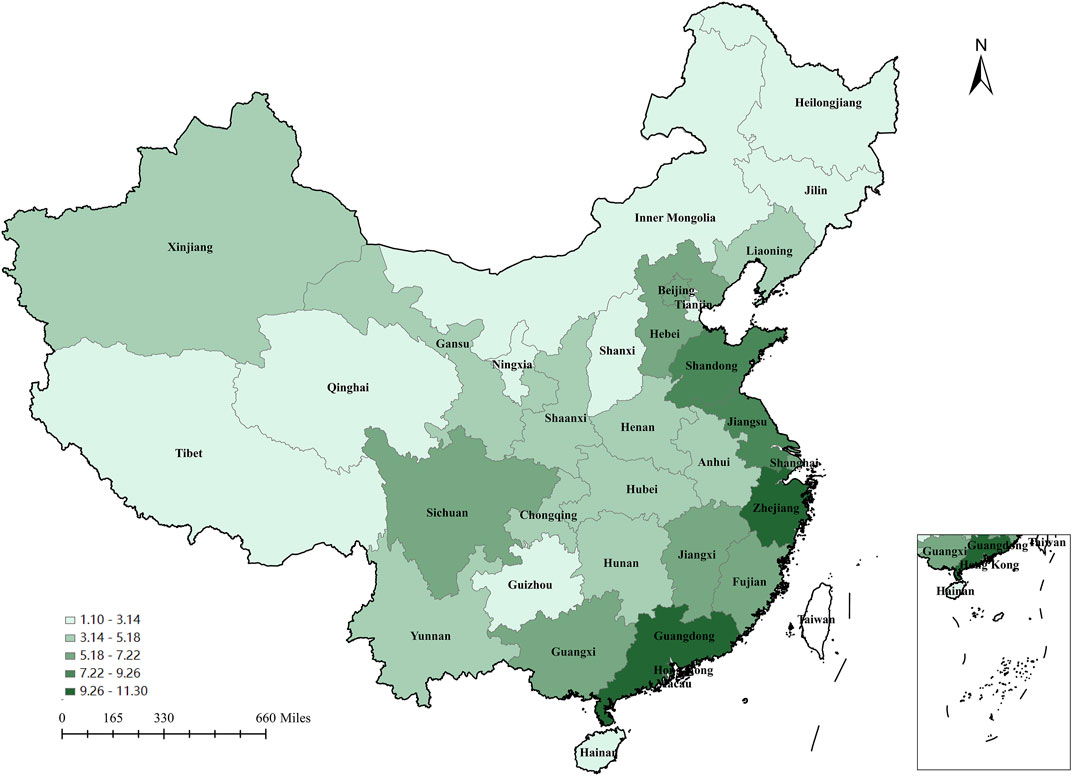
FIGURE 1. Carbon reduction potential of hotel industry in major provinces (based on green qualification level).
Conclusion and policy implication
(1) The research results show that the hotel’s construction stage and energy consumption are the major focus on emission reduction in a single hotel’s life cycle. Construction emission reduction is mainly for establishing new hotels, and the management agencies should put forward stricter requirements, such as developing more environmentally friendly standards so as to motivate hotel owners to select energy-saving and green design schemes, use recyclable building materials, and introduce new low-carbon technical equipment to complete the construction process. In terms of reducing energy consumption, also requires the joint efforts of the hotel itself and the management department. On the one hand, it is necessary to purchase environmental protection and energy-saving equipment, and to cultivate the energy-saving and environmental protection awareness of hotel service personnel; on the other hand, relevant departments need to reduce the supply of fuel for power generation in a reasonable way, to establish and improve the clean energy supply system, promote the scope of clean energy application, and speed up the realization of the green operation in the hotel industry.
(2) According to the overall carbon reduction calculation results of all the star-rated hotels, four-star hotels and five-star hotels have high carbon emissions. When formulating the carbon reduction policy of the hotel industry, these high-star hotels should also focus on carbon reduction, and then gradually implemented it in three-star and below hotels. In addition, the emission reduction potential of hotels in different provinces also varies greatly, and the management departments should adopt measures to local conditions, and promote the carbon reduction work of hotels orderly. Such as setting up some pilot areas in Guangdong, Zhejiang, and Jiangsu, the three major provinces of the hotel industry emissions, establishing a complete carbon emissions measurement mechanism, organizing professional teams to assess the management facilities and management of low carbon performance of local hotels regularly, and building a trading platform for the hotels to purchase quotas for unavoidable carbon emissions. In the future, this series of carbon reduction action plans will be further extended to the whole country.
Research limitations and discussion
The limitations of this study are concentrated in two aspects, one is the lack of time trend dynamic research, and the other is the lack of considering the difference in emission reduction potential of the same star hotels. This paper only calculates the carbon emission reduction potential of the hotel industry statically based on the statistical data of 2020 and does not analyze the emission reduction trend of the hotel industry from the time dimension. Scholars can continue to study the dynamic changes in carbon emission reduction in the hotel industry. In addition, due to the difficulty in obtaining data, this paper only calculates carbon emission reduction based on the average level of star-rated hotels. However, in reality, there may be great differences in the carbon emissions of the same-star hotels, and the carbon emission reduction potential of each-star hotel should also be a reasonable interval. The future calculation can do more in-depth subdivision research in this aspect.
Data availability statement
The original contributions presented in the study are included in the article/supplementary material, further inquiries can be directed to the corresponding author.
Author contributions
JQ conceived and designed the study. CS provided the data. ZG and JQ wrote the paper. ZG analyzed the results. All authors read and approved the manuscript.
Conflict of interest
The authors declare that the research was conducted in the absence of any commercial or financial relationships that could be construed as a potential conflict of interest.
Publisher’s note
All claims expressed in this article are solely those of the authors and do not necessarily represent those of their affiliated organizations, or those of the publisher, the editors and the reviewers. Any product that may be evaluated in this article, or claim that may be made by its manufacturer, is not guaranteed or endorsed by the publisher.
References
Chen, H., Zhu, S. G., He, K., Zhou, Z. M., et al. (2017). “Analysis of regional differences of Chinese star hotels based on GIS,” in Proceedings of the 2016 4th international conference on renewable energy and environmental technology, shenzhen, Peoples R China, 489–499.
Chen, L. F. (2019). Hotel chain affiliation as an environmental performance strategy for luxury hotels[J]. Int. J. Hosp. Manag. 77 (2), 1–6.
Department of Climate Change, National Development and Reform Commission (2014). China greenhouse gas inventory research 2005[M]. Beijing: China Environmental Science Press.
Department of Climate Change, National Development and Reform Commission (2011). Guidelines for compiling provincial greenhouse gas inventories (trial).
Energy Information Administration (2021). Annual energy outlook 2021[R]. Washington: Bipartisan Policy Center.
Filimonau, V., Dickinson, J., Robbins, D., and Huijbregts, M. (2011). Reviewing the carbon footprint analysis of hotels: Life cycle energy analysis (LCEA) as a holistic method for carbon impact appraisal of tourist accommodation. J. Clean. Prod. 19 (17-18), 1917–1930.
Fu, Y. Q., Chen, X. J., and Luo, Y. J. (2019). Construction and promotion of green hotel building technology application system [J]. J. Chongqing Jiaot. Univ. Soc. Sci. Ed. 19 (05), 26–34+44.
Geng, Z. W., Le, W., Guo, B. H., and Yin, H. J. (2020). Research on standardization and personalized service of green hotels [J]. Stand. China (02), 114–119.
He, S., and Yang, L. (2019). Research and analysis of carbon emission reduction in the hotel industry in Zhejiang Province [J]. Energy Eng. (05), 80–82.
Hu, A. H., Huang, C. Y., Chen, C. F., Kuo, C. H., and Hsu, C. W. (2015). Assessing carbon footprint in the life cycle of accommodation services: The case of an international tourist hotel [J]. Int. J. Sustain. Dev. World Ecol. 22 (4), 313–323.
Huang, K. T., Wang, J. C., and Wang, Y. C. (2015). Analysis and bench marking of greenhouse gas emissions of luxury hotels[J]. Int. J. Hosp. Manag. 51 (8), 56–66.
Huang, Q., Kang, J. C., and Huang, C. H. (2014). Research on carbon emission assessment and energy saving and emission reduction potential of hotel industry [J]. Resour. Sci. 36 (05), 1013–1020.
IPCC (2019). The 2019 refinement to the 2006 IPCC guidelines for national greenhouse gas inventories (revised in 2019)[R]. Tokyo: National Greenhouse Gas Inventories.
Ke, L., and Leng, J. W. (2020). Quantified CO2-related indicators for green building rating systems in China: Comparative study with Japan and taiwan[J]. Indoor Build Environ. 30 (6), 763–776.
LB/T 007 (2015). Green tourist hotel[S]. Beijing: National Public Service Platform for Standards Information.
LB/T 018 (2011). Guidelines for energy conservation and emission reduction in tourist hotels[S]. Beijing: Ministry of Culture and Tourism of the People’s Republic of China.
Li, J., Li, X., and Chen, C. (2021). The CO2 emission efficiency of China’s hotel industry under the double carbon objectives and homestay growth. Energies 14 (24), 8228–8247.
Michailidou, A. V., Vlachokostas, C., Moussiopoulos, N., and Maleka, D. (2016). Life Cycle Thinking used for assessing the environmental impacts of tourism activity for a Greek tourism destination [J]. J. Clean. Prod. 111 (1), 499–510.
Ministry of Culture and Tourism of the People’s Republic of China (2020). Statistical Bulletin of Chinese star-rated hotels.
Oluseyi, P. O., Babatunde, O. M., and Babatunde, O. A. (2016). Assessment of energy consumption and carbon footprint from the hotel sector within Lagos, Nigeria[J]. Energy & Build. 118 (4), 106–113.
Peng, Z., Guo, C. M., Wang, L. L., and Li, S. Y. (2021). Research on CO2 emission sensitivity and carbon reduction potential of green building life cycle [J]. J. Tianjin Urban Constr. Univ. 27 (06), 436–441.
Salehia, M., Filimonaub, V., Asadzadehc, M., and Ghaderia, E. (2021). Strategies to improve energy and carbon efficiency of luxury hotels in Iran. [J] Sustain. Prod. Consum. (26), 1–15.
Schwartz, Y. R., Raslan, R., and Mumovic, D. (2018). The life cycle carbon footprint of refurbished and new buildings - a systematic review of case studies[J]. Renew. Sustain. Energy Rev. 55 (01), 231–241.
Shen, Y., Hu, Y. C., Shi, Y. L., Zhang, Q. H., Zhang, H. M., Cui, S. H., et al. (2017). Carbon emission accounting and low carbon index analysis of urban hotel industry [J]. J. Environ. Sci. 37 (03), 1193–1200.
Wang, K., Liu, Y. F., and Gan, C. (2022). Spatial spillover effect of tourism industry agglomeration on tourism carbon emission efficiency [J]. Chin. J. Ecol. (10), 1–10.
Keywords: traditional hotel, green transformation, carbon reduction measurement, carbon peaking and carbon neutrality, the hotel industry
Citation: Qiu J, Guo Z and Sun C (2022) Carbon emission reduction calculation for the green transformation of traditional hotel design. Front. Energy Res. 10:985336. doi: 10.3389/fenrg.2022.985336
Received: 03 July 2022; Accepted: 23 August 2022;
Published: 27 September 2022.
Edited by:
Xiaoqi Sun, Shenzhen University, ChinaReviewed by:
Nanfei Jia, Beijing Technology and Business University, ChinaHuiling Zheng, China University of Geosciences, China
Copyright © 2022 Qiu, Guo and Sun. This is an open-access article distributed under the terms of the Creative Commons Attribution License (CC BY). The use, distribution or reproduction in other forums is permitted, provided the original author(s) and the copyright owner(s) are credited and that the original publication in this journal is cited, in accordance with accepted academic practice. No use, distribution or reproduction is permitted which does not comply with these terms.
*Correspondence: Chuanwang Sun, Y3dfc3VuQGZveG1haWwuY29t
 Jing Qiu1,2
Jing Qiu1,2 Chuanwang Sun
Chuanwang Sun
